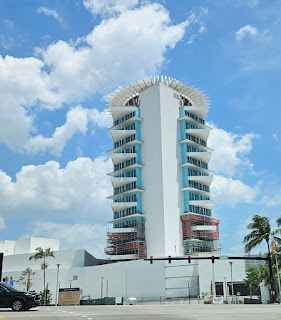 |
| Merle Fogg Florida State Archives/Florida Memory |
By Jane Feehan
Fort Lauderdale’s first airport, Merle Fogg Field, opened on an abandoned golf course May 1, 1929 – a year after its namesake died in an air crash in West Palm Beach.
Several firsts are credited to Merle Fogg (1898-1928), Fort Lauderdale’s first aviator. He was the first licensed pilot in Maine, the first to fly a plane from Maine to Florida, the first to land a plane on Andros Island and on New Providence Island (Nassau).
With his airplane, Fogg helped create a snapshot of Broward County during good and bad times. His flights over the county provided a picture of possibilities during the land boom days of the early 1920s. After the hurricane of 1926, Fogg flew reporters over its aftermath, giving them an opportunity to capture the extent of the storm’s destruction.
On the day of the fatal crash, Fogg had invited 22-year-old Thomas Lochrie, son of Fort Lauderdale pioneer and president of Broward Bank and Trust Co., John Lochrie, on a ride to Miami to photograph the Shrine convention. When he returned to the hangar, student pilot C.S. Nelson invited them for a ride. Nelson was at the controls when the plane went into a tailspin and crashed. He survived with minor injuries; Fogg and Lochrie were killed.
A year later, the city of Fort Lauderdale converted Southside Golf Course into Merle Fogg Field. Fogg had long hoped the city would open an air field. The Fort Lauderdale Naval Air Station opened at the site during World War II and today, Merle Fogg Field is the site of the Fort Lauderdale-Hollywood International Airport.
Merle Fogg is buried in Bangor, Maine.
Merle Fogg is buried in Bangor, Maine.
Copyright © 2020. All rights reserved. Jane Feehan
Sources:
Weidling, Philip J. , Burghard, August. Checkered Sunshine. Gainesville: University of Florida Press (1966).
Fort Lauderdale News, May 7, 1978
Tags: Fort Lauderdale history, Fort Lauderdale's first aviator, Merle Fogg, Fort Lauderdale-Hollywood International Airport, film researcher, History of Fort Lauderdale


















